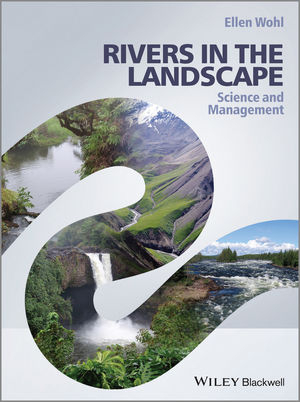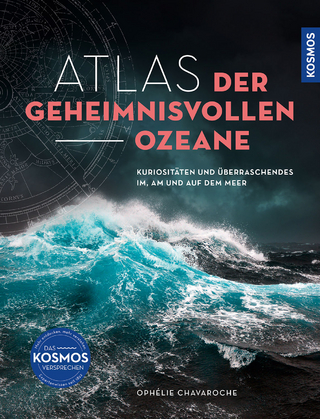
Rivers in the Landscape
John Wiley & Sons Inc (Verlag)
978-1-118-41489-7 (ISBN)
- Titel erscheint in neuer Auflage
- Artikel merken
Rivers in the Landscape: Science and Management offers a comprehensive and accessible overview of the current state of knowledge for river process and form, taking a holistic approach to the subject with coverage of integrated river science and management in practice.
The processes and forms present in channelized surface flow rivers are systematically explored in this book to emphasize the connectivity between rivers and the greater landscape by explicitly considering the interactions between rivers and tectonics, climate, biota, and human activities; provide a concise summary of the current state of knowledge for physical process and form in rivers; reflect the diversity of river environments, from mountainous, headwater channels to large, lowland, floodplain rivers and from the arctic to the tropics; reflect the diverse methods that scientists use to characterize and understand river process and form, including remote sensing, field measurements, physical experiments, and numerical simulations; reflect the increasing emphasis on quantification in fluvial geomorphology and the study of Earth surfaces in general; provide both an introduction to the classic, foundational papers on each topic, and a guide to the latest, particularly insightful and integrative references.
Aimed at advanced undergraduate students, graduate students, and professionals looking for a concise summary of physical aspects of rivers, this book emphasizes general principles and conceptual models, as well as concrete examples of each topic drawn from the extensive literature on river process and form.
Ellen Wohl Department of Geosciences, Colorado State University, Colorado, USA
Acknowledgements ix About the Companion Website xi Chapter 1 Introduction 1 1.1 Connectivity and inequality 1 1.2 Six degrees of connection 3 1.3 Rivers as integrators 6 1.4 Organization of this volume 7 1.5 Understanding rivers 9 1.5.1 The Colorado Front Range 9 1.6 Only connect 19 Chapter 2 Creating channels and channel networks 21 2.1 Generating water, solutes, and sediment 21 2.1.1 Generating water 21 2.1.2 Generating sediment and solutes 22 2.2 Getting water, solutes, and sediment downslope to channels 23 2.2.1 Downslope pathways of water 23 2.2.2 Downslope movement of sediment 29 2.2.3 Processes and patterns of water chemistry entering channels 32 2.2.4 Influence of the riparian zone on fluxes into channels 32 2.3 Channel initiation 34 2.4 Extension and development of the drainage network 37 2.4.1 Morphometric indices and scaling laws 37 2.4.2 Optimality 40 2.5 Spatial differentiation within drainage basins 41 2.6 Summary 43 Channel processes I 45 Chapter 3 Water dynamics 47 3.1 Hydraulics 47 3.1.1 Flow classification 48 3.1.2 Energy, flow state, and hydraulic jumps 51 3.1.3 Uniform flow equations and flow resistance 53 3.1.4 Velocity and turbulence 60 3.1.5 Measures of energy exerted against the channel boundaries 65 3.2 Hydrology 67 3.2.1 Measuring, indirectly estimating, and modeling discharge 67 3.2.2 Flood frequency analysis 71 3.2.3 Hydrographs 73 3.2.4 Other parameters used to characterize discharge 75 3.2.5 Hyporheic exchange and hydrology 77 3.2.6 River hydrology in cold regions 77 3.2.7 Human influences on hydrology 78 3.3 Summary 79 Channel processes II 81 Chapter 4 Fluvial sediment dynamics 83 4.1 The channel bed and initiation of motion 84 4.1.1 Bed sediment characterization 84 4.1.2 Entrainment of non-cohesive sediment 85 4.1.3 Erosion of cohesive beds 89 4.2 Sediment transport 91 4.2.1 Dissolved load 91 4.2.2 Suspended load 94 4.2.3 Bed load 98 4.3 Bedforms 104 4.3.1 Readily mobile bedforms 105 4.3.2 Infrequently mobile bedforms 108 4.3.3 Bedforms in cohesive sediments 115 4.4 In-channel depositional processes 115 4.5 Bank stability and erosion 117 4.6 Sediment budgets 120 4.7 Summary 124 Chapter 5 Channel forms 125 5.1 Cross-sectional geometry 125 5.1.1 Bankfull, dominant, and effective discharge 125 5.1.2 Width to depth ratio 127 5.1.3 Hydraulic geometry 128 5.1.4 Lane s balance 130 5.1.5 Complex response 132 5.1.6 Channel evolution models 133 5.2 Channel planform 133 5.2.1 Straight channels 135 5.2.2 Meandering channels 136 5.2.3 Wandering channels 139 5.2.4 Braided channels 139 5.2.5 Anabranching channels 142 5.2.6 Compound channels 143 5.2.7 Karst channels 144 5.2.8 Continuum concept 144 5.2.9 River metamorphosis 146 5.3 Confluences 147 5.4 River gradient 149 5.4.1 Longitudinal profile 151 5.4.2 Stream gradient index 153 5.4.3 Knickpoints 154 5.5 Adjustment of channel form 156 5.5.1 Extremal hypotheses of channel adjustment 157 5.5.2 Geomorphic effects of floods 157 5.6 Downstream trends 160 5.6.1 Grain size 160 5.6.2 Instream wood 161 5.7 Summary 163 Chapter 6 Extra-channel environments 165 6.1 Floodplains 165 6.1.1 Depositional processes and floodplain stratigraphy 167 6.1.2 Erosional processes and floodplain turnover times 172 6.1.3 Downstream trends in floodplain form and process 174 6.1.4 Classification of floodplains 175 6.2 Terraces 175 6.2.1 Terrace classifications 176 6.2.2 Mechanisms of terrace formation and preservation 176 6.2.3 Terraces as paleoprofiles and paleoenvironmental indicators 179 6.3 Alluvial Fans 181 6.3.1 Erosional and depositional processes 182 6.3.2 Fan geometry and stratigraphy 183 6.4 Deltas 185 6.4.1 Processes of erosion and deposition 186 6.4.2 Delta morphology and stratigraphy 187 6.4.3 Paleoenvironmental records 190 6.4.4 Deltas in the Anthropocene 191 6.5 Estuaries 192 6.6 Summary 194 Chapter 7 Humans and rivers 197 7.1 Indirect impacts 198 7.1.1 Climate change 198 7.1.2 Altered land cover 200 7.2 Direct impacts 205 7.2.1 Flow regulation 205 7.2.2 Altered channel form and connectivity 208 7.3 River management in an environmental context 215 7.3.1 Reference conditions 215 7.3.2 Restoration 217 7.3.3 Instream, channel maintenance, and environmental flows 221 7.4 River health 223 7.5 Summary 224 Chapter 8 Rivers in the landscape 225 8.1 Rivers and topography 225 8.1.1 Tectonic influences on river geometry 226 8.1.2 Effects of river incision on tectonics 228 8.1.3 Indicators of relations between rivers and landscape evolution 228 8.1.4 Tectonics, topography, and large rivers 229 8.2 Geomorphic process domains 230 8.3 Connectivity 232 8.4 Climatic signatures 234 8.4.1 High latitudes 234 8.4.2 Low latitudes 235 8.4.3 Warm drylands 236 8.5 Rivers with a history 237 8.5.1 Upper South Platte River drainage, Colorado, USA 240 8.5.2 Upper Rio Chagres, Panama 242 8.5.3 Mackenzie River drainage, Canada 244 8.5.4 Oregon Coast Range, USA 246 8.5.5 YumaWash, Arizona, USA 248 8.6 The greater context 250 References 255 Index 311
| Verlagsort | New York |
|---|---|
| Sprache | englisch |
| Maße | 192 x 249 mm |
| Gewicht | 630 g |
| Themenwelt | Naturwissenschaften ► Geowissenschaften ► Hydrologie / Ozeanografie |
| ISBN-10 | 1-118-41489-6 / 1118414896 |
| ISBN-13 | 978-1-118-41489-7 / 9781118414897 |
| Zustand | Neuware |
| Haben Sie eine Frage zum Produkt? |
aus dem Bereich



